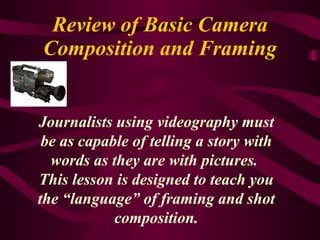Shot framing
- 1. Review of Basic Camera Composition and Framing Journalists using videography must be as capable of telling a story with words as they are with pictures. This lesson is designed to teach you the âlanguageâ of framing and shot composition.
- 2. Framing Establishing shot-An opening shot of a scene, segment or productionâĶused to establish location, mood, setting, time of day; taken with a wide field of view (W) Detail shot-shows detail of the subject in a telephoto/narrow angleâĶgood for focusing the viewersâ attention on a subject such as expressions; taken with a narrow field of view (T) Dialogue shot-frame up the subjectâs upper body and face to see what theyâre saying and how theyâre interacting with another person(s). There are seven (7) typical FIELDS OF VIEW These are used to frame the subject on-screen .
- 3. Extreme close up (ecu)
- 5. Medium close up (mcu)
- 7. Medium long shot (mls)
- 9. Extreme long shot (els)
- 10. More on Framing Noseroom The space left in front of nose of person talking to give believability that there is someone off screen they are talking with.
- 11. Headroom The space left at top of head and top of frameâĶimportant since too much headroom looks like the person is short and not enough looks like theyâre bumping their head on the top of the frame. Not enough Too much
- 12. Leadroom The space left in front of the moving subject to give the believability that there is some place they are going.
- 13. Background Composition Tilted horizon -the vertical and horizontal lines are inconsistent with the frame. IT LOOKS SLANTED. Frame up lines with edges of frame. Street sign or plant behind the head -looks like the object is coming out of someoneâs head. Move person away from sign or move the plant.
- 14. Tonal Mergers Be careful to make sure the colour and tone of your foreground does not blend into the background. It is difficult to see the butterfly in this picture
- 15. Creating Depth Because images are two-dimensional, it is important to give the illusion of depth by lengthening the âzâ axis. Shooting images with a foreground, mid-ground, and background can lengthen the Z axis and create more depth.
- 16. Rule of Thirds Placement of subject(s) and cut off points all fall within 3rds of the frame.
- 17. Mental Map (also known by Herbert Zettl as âpsychological closureâ) Mentally filling in spaces of an incomplete picture. Be careful not to cut people off at the neck or at the knees
- 18. Shot set-up for continuity editing It is important to have a quick lesson in editing so that you can set up your shots in a way that wonât confuse the viewer.
- 19. Vector Lines When cameras cross the 180 degree line, screen positions are changed and motion continuity is reversed and confused. Keeping the mental map intact requires proper vector continuity Cameras must be kept on the same side of the vector line
- 20. Dialogue Vector A relationship is set up between individuals in conversation by setting up shots and sequencing them back to back. This relationship is set up with a â2-shotâ of the conversation. The 2-shot is often followed by a âcross shotâ or an âover the shoulder shotâ, which is used to maintain this connection between individuals.
- 21. Dialogue Vectors Contâd In conversational sequences, Person A should stay on the left and person B should stay on the right. This allows the viewer to mentally map the subjectsâ positions. Incorrect Vector Sequence -Crossing the vector A B B A
- 22. Correct Dialogue Vector Notice how person A stays on the left while person B stays on the right? A B A B
- 23. Motion Vectors Be careful not to cross the 180 degree line of action or it will look like your subject has switched direction























